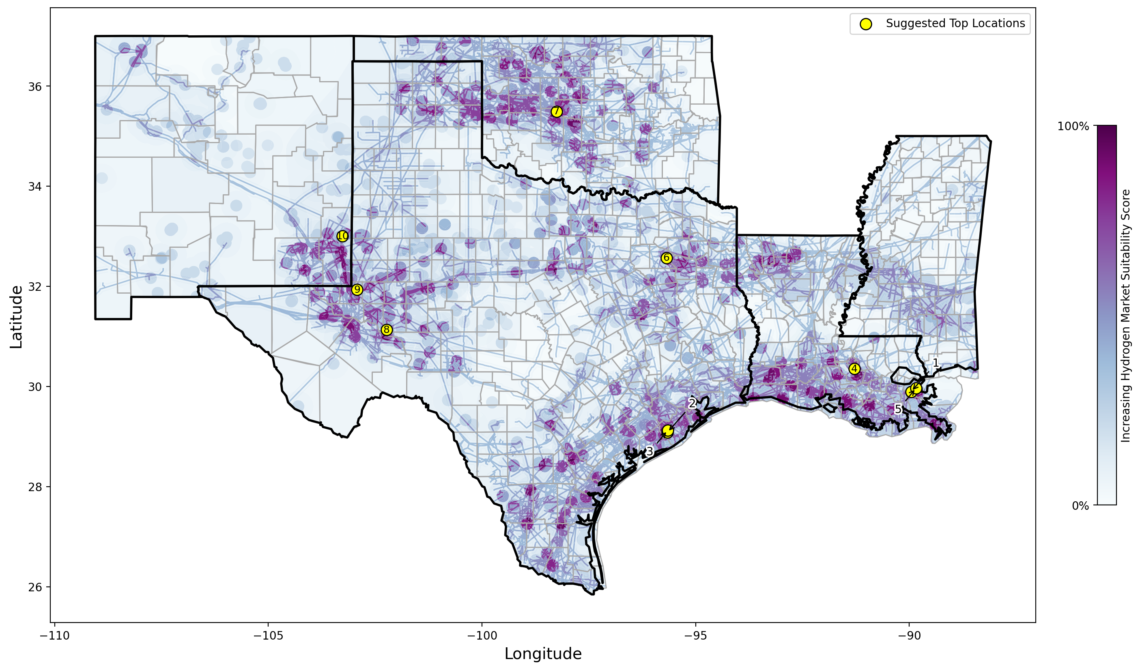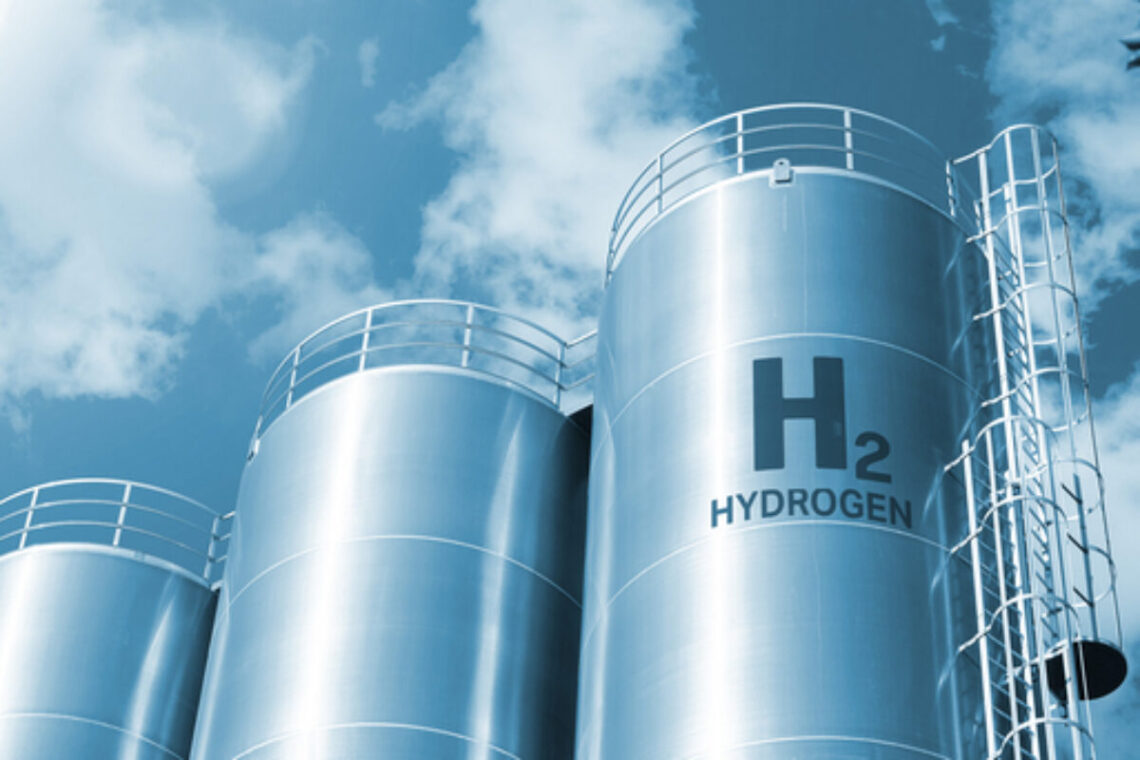Enabling a hydrogen energy economy in Texas.
The University of Texas at Austin conducts cutting-edge applied research to advance knowledge, drive innovation in hydrogen technologies, and prepare the next generation of scientists and engineers to convert emerging technologies into a powerful hydrogen economy. First-of-a-kind hydrogen testing sites include the Hydrogen ProtoHub and the subsurface aquifer GeoH2 testing site in development.
Hydrogen ProtoHub
Located at UT Austin’s J.J. Pickle Research Campus, the Hydrogen ProtoHub generates zero-carbon hydrogen using water electrolysis powered by solar and wind energy, as well as steam methane reformation of renewable natural gas from a Texas landfill. The hydrogen powers a stationary fuel cell for clean, reliable power for the Texas Advanced Computing Center and supplies zero-emission fuel to a fleet of fuel cell electric vehicles. Marking the first time multiple renewable hydrogen supplies and multiple end uses have been networked at a single location to demonstrate a scalable, economical hydrogen ecosystem. The Hydrogen ProtoHub facility is co-operated by UT’s Center for Electromechanics and GTI Energy.
HyFive by GeoH2: Advancing Hydrogen Investment Opportunities
The GEOH2 group at UT Austin has created HyFive, an online interactive platform designed to support the evaluation and screening of hydrogen storage opportunities. HyFive integrates geospatial analysis with robust economic modeling, enabling users to identify commercially viable hydrogen storage locations that align with existing infrastructure and market dynamics. As a key tool in driving hydrogen adoption, HyFive empowers stakeholders, from industry to policymakers, with actionable insights into hydrogen investment opportunities. The platform facilitates informed decision-making by visualizing critical data points such as geological suitability, infrastructure proximity, and cost projections.
Several sponsors, including participants in the HyVelocity Hub in Texas are currently using the tool to help optimize their hydrogen infrastructure.

UT Joins Industry in Report to Legislature to Advance Texas’ Hydrogen Economy

UT Austin joined top energy companies in issuing a report to the Texas Legislature advising the steps it could take to advance the state’s growing hydrogen industry. The report, issued by the Texas Hydrogen Production Policy (TxH2) Council, provided several key recommendations focusing on safety, environmental protection, and regulatory clarity and efficiency. UT is the only university represented on the council.
UT Energy Expertise to Guide HyVelocity Hub, New Gulf Coast Hydrogen Hub, as Lead Academic Founding Partner
UT Austin will partner with industry and the U.S. Department of Energy’s Office of Clean Energy Demonstrations (OCED) to build and expand a hub for hydrogen energy production along the Texas Gulf Coast that will help increase and diversify the nation’s energy supply.

Our mission is to help enable a hydrogen economy.
Hydrogen economy promises
- New jobs
- Transportation fuel from water, wind, and solar
- Reduced emissions
- Higher efficiency
Meeting the promise requires
- Research
- Development
- Demonstration
- Government policies
UT is an academic leader in comprehensive hydrogen R&D and education
- Improved materials
- Better technology
- Engineering data
- Techno-economic analysis
Educated students are needed to convert emerging technology into a growing economy.

Why UT?

The University of Texas at Austin (UT) is a first-class public institution conducting high-impact research.
- #7 – Top U.S. Public Universities – Center for World University Rankings
- #32 – Best Global Universities – U.S. News & World Report
- $683M Research Expenditures (2018)
- 786 Patents Since 2008

The Cockrell School of Engineering (CSE) is the number one engineering program in Texas, and has been a global leader in technology advancement and engineering education for over a century.
- #10 – Best Engineering Program in the World – Academic Ranking of World Universities
- 15 Undergrad and Grad Programs Ranked in the Top 10 – U.S. News & World Report
- 2019 Nobel Prize in Chemistry – Professor John B. Goodenough
- 4 National Medal Winners

The Jackson School of Geosciences (JSG) is one of the country’s oldest geoscience departments and the world’s largest academic geosciences community.
- #7 – Earth Sciences Overall – U.S. News & World Report
- #1 – Geology – U.S. News & World Report
- #6 – Geophysics & Seismology – U.S. News & World Report
- #3 – Geology Worldwide – 2017 Center for World University Rankings

The College of Natural Sciences (CNS) is one of the largest colleges of science in the U.S., with a community of more than 12,000 undergraduate and graduate students and 700 faculty members.
- 12 Undergrad and Graduate Programs Ranked in the Top 10 – U.S. News & World Report
- 22 Members of the National Academies
- 3 Wolf Prize Winners, including the 2020 Wolf Prize in Physics – Professor Allan H. MacDonald
- 15 World-Class Centers and Institutes

The Energy Institute (EI) connects the resources of UT’s top-ranked programs— including engineering, business, geosciences, natural sciences, architecture, law and public affairs— to catalyze bold innovation around key energy challenges.
The Energy Institute is fueling a sustainable energy transition, bringing together the expertise of more than 450 energy-related faculty and researchers and over 30 energy centers and programs at UT, while supporting strategic collaboration with partners in government and industry.

